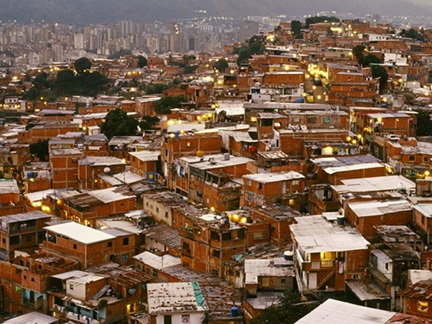shortlisted webdocumentary
The places we live
Article published on the 2009-08-18 Latest update 2009-08-26 11:28 TU
The Places We Live is a webdocumentary from Norwegian photographer Jonas Bendiksen. It is based on work he did in four slums around the world, in Caracas (Venezuela), Mumbai (India), Nairobi (Kenya) and Jakarta (Indonesia).
"I started thinking about it in 2002 and photographing it in 2005," he says, "the photography went through to 2007".
Although, as Bendiksen points out, you could do a project like this in any of thousands of locations around the world, the locations were not completely arbitrary.
"I wanted a geographical spread of the four different locations, spread out on the continents and I wanted to find four rather different types of slum, he says".
Bendiksen says that he started thinking about what the planet would look like when his son reached his age. This was in 2008, around the time the UN announced that the world's urban population had overtaken the number of people in rural areas, for the first time ever.
The number of slum dwellers reached one billion the same year.
"These two amazing figures together," he says, "said that the urban slum was essentially the fastest growing human habitat on the planet. Before too many years will have passsed, the urban slum will, in many ways, become the norm rather than the exception in human habitation - at least in urban habitation".
He says the idea of using different media to tell the stories of life in the slums was there from the beginning, in part to involve the subjects more in telling the story.
"We've seen how many stories about poverty?" he asks rhetorically, "at Visa pour l'Image every year, how many stories do we see about poverty?"
"It's sort of a little favourite topic among photojournalists. The sort of visual material we bring back is really pretty meaningless. I was trying to think of other ways that we could really bring out the enormous diversity, the incredible variety, of personal stories in the slum".
He says he planned to make a book from his work. This became the publication of the same name, published by Aperture, and is now available in seven languages.
He also planned to create an exhibition - which is about to open in Washington after a period in Oslo. After the US it will carry on to Berlin and then to Shanghai.
"In the exhibition installation there are actually four rooms. Each room represents one city and you actually step into the room and the room all round you, 360°, comes alive. And you stand inside the photograph while you're hearing the stories spoken over a loudspeaker".
As he designed the book and exhibition he realised that it was a project that would lend itself to the web. "It was very much conceived as a project where I wanted to use the same device put into all these different incarnations", he explains.
He says that working on several media improved the quality of his documentation while he was in the field, forcing him into closer contact with the subjects than he might have had as a straight photographer.
"It was really about sitting down with people, getting to know them, he says, "I think it made people really interested and really want to positively be part of the project much more than if I was just running through the streets snapping away".






